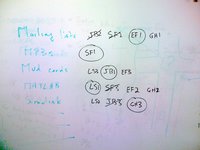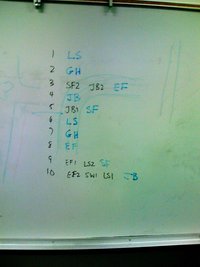CDS 101/110a, Fall 2007 - TA assignments
See current course homepage to find most recent page available. |
| CDS 101/110a | Schedule | Recitations | FAQ | AM08 (errata) |
This page contains information about TA activities for CDS 101/110a, Fall 2007. Unlike prior years, I am going to try not having a head TA, but instead distributing those responsibilities to different TAs.
Assignments
Course responsibilities
- Mailing list administration (Richard and Elisa Franco) - approve valid postings to the TA and class mailing lists. Manage subscriptions to the list and fix any problems. Admin pages for the lists: cds101-students, cds101-tas
- Recording lectures (Sawyer Fuller) - record each lecture that Richard gives and place it online after the lecture.
- Mud cards (Julia Braman) - collect mud cards at the end of the lecture and distribute to the other TAs to be answered that evening.
- MATLAB review (Luis Soto) - present the MATLAB review in the first week of class and generally respond to questions from the students regarding MATLAB. Place MATLAB examples on the wiki as needed.
- SIMULINK review (George Hines) - present the SIMULINK review in the first week of class and generally respond to questions from the students regarding SIMULINK. Place SIMULINK examples on the wiki as needed.
Weekly TA assignments
Each week a different TA will be responsible for helping with the homework problems (and solutions). The work to be done includes:
- Prior week: look through the homework problems and solutions, flagging any issues to Richard; look through the wiki pages for the lecture and make sure all links work
- Assigned week: take the lead on answering questions related to the homework. Lead a discussion at the TA meeting on any issues that may come up in the recitation sections related to the homework
- Following week: decide how to divide up the grading between the TAs; tally all of the homework scores (and times) in the grading spreadsheet. The TA for the current week should not grade in that week (so for HW 1, George would not grade; for HW 2, Elisa would not grade, etc).
- Week 1 - Luis Soto
- Week 2 - George Hines
- Week 3 - Elisa Franco
- Week 4 - Julia Braman
- Week 5 (midterm review) - Sawyer Fuller
- Week 6 - Luis Soto
- Week 7 - George Hines
- Week 8 - Elisa Franco
- Week 9 - Sawyer Fuller
- Week 10: (final review) - Julia Braman
Recitations
Starting in the third week of the class, we'll have recitations on Fridays from 2-3 pm. Each TA will lead a recitation section, with the sections having slightly different "flavors" (see the recitation schedule for information and assignments). Each recitation section should cover roughly the following things (not necessarily in this order):
- Answer any questions the students have about the lecture or the homework
- Discuss topics that you thought were not well covered in lecture or the text book, or that are special to your section (eg, the information systems session might get some information about discrete time systems, etc)
- Go through one of the problems on the homework for the week. This should be done on the board and/or computer (depending on the type of problem). It doesn't need to be in full detail and it can go a bit fast, but provide enough information that the students see how the problem is worked from start to finish, and what is expected in their answers on the homework. We'll decide on the problem to cover in the TA meeting prior to the recitation.
Office hours
We'll have two hours of office hours each week. The tentative times are
- Sun 4-5 pm
- Tue 3-4 pm?
We'll initially assign 1 TA to each office hour (the assigned TA for the week plus one other) but we can change that if the office hours get busy.
HOWTOs
This section contains information for the TAs on how to perform various tasks in the class.
Creating FAQ pages
To create a FAQ page, you need to do the following steps:
- Search the previous FAQ pages to see if this question has already been asked. If so, update the answer and skip to step 5
- Type in the question to be answered in the search box on the left side of the wiki.
- Click on the phrase "this exact title" when the search page comes up. This will create the FAQ page.
- Enter the answer to the question. You don't need to repeat the question (it is already included in the title for the page).
- At the end of the answer, use the text '--~~~~' to add your signature to the page. If you are modifying the answer on an existing page, add your signature below the existing signature. When you save the page, this information will get converted into your username and date (you can edit it again if you don't like the format).
- At the bottom of the page, add the category information (used to list the FAQs in the right places):
[[Category: CDS 101/110 FAQ - Lecture w-m]] [[Category: CDS 101/110 FAQ - Lecture w-m, Fall 2007]]
where 'w' is the current week and 'm' is the lecture number (1 = Monday, 2 = Wednesday, 3 = Friday). For homework sets, replace 'Lecture w-m' with 'Homework n'. - Save the page
Notes on creating FAQ pages
- The title doesn't have to be exactly what was written in the MUD card, but should be close enough that the student will recognize their question. You should reword the question to be simply stated and descriptive of the contents of the FAQ.
- When you are writing up the answer for a FAQ, remember that this is the first course the students are taking in feedback and control. Avoid the use of advanced concepts that the students haven't seen yet and try to explain things in a way that gives insight to someone who may be struggling to understand the concept.
- Including pictures to illustrate your answers is a great approach if appropriate. OK to grab pictures off of the web, but make sure to list where they came from (and include a link if you can).
- You should also look in the course text to see if there is information there that might be relevant (students are asking questions in class, so may not have read the book yet). Include the relevant section number where more information can be found, but go ahead and provide additional explanation as well.
Course Statistics
22 Sep enrollment information
- CDS 101: 3 students enrolled, all juniors. 2 ACM, 1 CNS
- CDS 110a: 44 students enrolled. 1 sophomore (ACM), 19 juniors, 21 seniors, 3 G2s (2 EE, 1 SS). Option breakdown for juniors and seniors: Ae (5), ChE (1), CNS (1), CS (1), EE (5), Ge(1), Ma(1), ME (24), Ph (1)
- We'll probably have 15-20 first year graduate students (based on past years), so a total class size of about 65 students.
Organizational Meeting
Goals
- Review the structure and features of CDS 101/110a
- Decide on assignments of tasks for the term
Agenda
CDS 101 vs CDS 110a
- Two courses taught through shared lectures
- CDS 101: principles and tools; aimed at non-specialists
- CDS 110: principles, tools and derivations: aimed at engineering audience
- Monday lecture: overview of material for the week; shared
- Wednesday lecture: CDS 110 only; more detailed analysis, proofs, etc
- Friday recitation (new this year): work through one of the problems on the homework
Course Demographics
- Typically have 70-80 students per year (up 100% from a decade ago)
- Students come from a wide variety of backgrounds (ME, Ae, EE, BE, CS, APh, ...)
- Most students are in CDS 110; 2-8 students in CDS 101
- Recitation sections may be used to cater to different audiences
Teaching Techniques
- Course wiki
- Mud cards
- MP3 files for lectures
- Hours reported on homework
- Background, midterm and final surveys
Recitation Sections
- All recitations will be on Fridays, 2-3 pm
- Recitations will work through one problem from homework set on the board/computer
- Can we tune the recitations to be useful for students with a different background?

